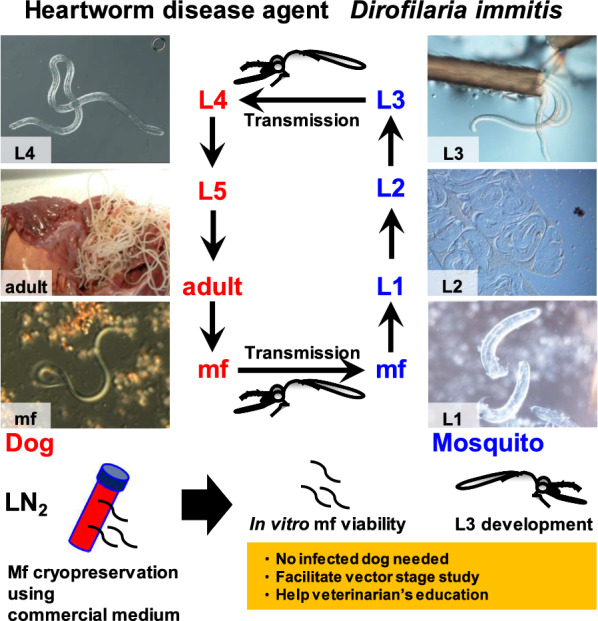- Record: found
- Abstract: found
- Article: found
Identification and validation of a commercial cryopreservation medium for the practical preservation of Dirofilaria immitis microfilaria

Read this article at
Abstract
Background
Dirofilaria immitis is a parasitic nematode transmitted by mosquitoes and the cause of heartworm disease in dogs and dirofilariasis in humans and other mammals. The parasite is endemic worldwide. Vector stage research requires a reliable supply of D. immitis microfilariae (mf). It is believed that cryopreserved mf would retain viability and provide a powerful tool for vector stage research. However, reports on cryopreservation of D. immitis mf are limited. Therefore, this study aimed to validate commercial cryopreservation media to establish a practical, convenient and reproducible storage procedure for D. immitis mf.
Methods
Six different commercially available cryopreservation media were compared with the traditional polyvinylpyrrolidone-dimethyl sulfoxide (PVP-DMSO) preservation solution. In vitro viability of purified D. immitis mf and mf-infected total blood was analyzed using a motility assay and propidium iodide staining. In vivo infectivity of Aedes aegypti mosquitoes with cryopreserved mf was assessed using a mosquito survival test and quantifying the number of third-stage larvae (L3) after 13 days post-infection.
Results
Purified mf cryopreserved in CultureSure showed the best viability when compared to mf cryopreserved in the remaining five commercially available media and PVP-DMSO. Viability of mf in mf-infected total blood cryopreserved in CultureSure varied with the ratio of infected blood to CultureSure. Optimum results were obtained with 200 µl mf-infected blood:800 µl CultureSure. CultureSure was also the optimum medium for cryopreserving mf prior to infectivity of A. aegypti. The number of L3 was approximately the same for CultureSure cryopreserved mf (3× concentrated solution) and non-cryopreserved fresh mf.
Conclusions
CultureSure is an optimal commercial cryopreservation solution for the storage of D. immitis purified mf, mf-infected total blood, and mf used for in vivo mosquito experiments. Furthermore, this study describes an easy preservation method for clinical D. immitis-infected blood samples facilitating vector stage studies, as well as the study of macrocyclic lactone resistance in heartworms and the education of veterinarians.

Related collections
Most cited references20
- Record: found
- Abstract: found
- Article: not found
Human and animal dirofilariasis: the emergence of a zoonotic mosaic.
- Record: found
- Abstract: found
- Article: found
Heat treatment prior to testing allows detection of antigen of Dirofilaria immitis in feline serum
- Record: found
- Abstract: found
- Article: not found